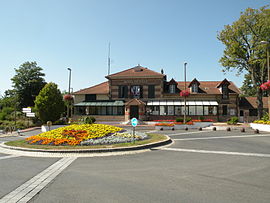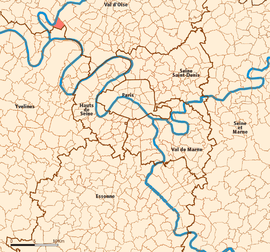Éragny, Val-d'Oise
Éragny | |
|---|---|
 Town hall | |
 Location (in red) within Paris inner and outer suburbs | |
| Coordinates: 49°01′05″N 2°05′32″E / 49.0181°N 2.0922°E | |
| Country | France |
| Region | Île-de-France |
| Department | Val-d'Oise |
| Arrondissement | Pontoise |
| Canton | Cergy-2 |
| Intercommunality | Cergy-Pontoise |
| Government | |
| • Mayor (2014–2020) | Thibault Humbert |
Area 1 | 4.72 km2 (1.82 sq mi) |
| Population (2006) | 16,652 |
| • Density | 3,500/km2 (9,100/sq mi) |
| Time zone | UTC+01:00 (CET) |
| • Summer (DST) | UTC+02:00 (CEST) |
| INSEE/Postal code | 95218 /95610 |
| Elevation | 22–56 m (72–184 ft) |
| 1 French Land Register data, which excludes lakes, ponds, glaciers > 1 km2 (0.386 sq mi or 247 acres) and river estuaries. | |
Éragny (sometimes unofficially called Éragny-sur-Oise) is a commune in the northwestern suburbs of Paris, France. It is located 26.3 km (16.3 mi) from the center of Paris, in the "new town" of Cergy-Pontoise, created in the 1960s.
Inhabitants are called Éragniens.
History
- 1968: 3638
- 1975: 3638
- 1982: 15,034
- 1990: 16,939
- 2006: 16,652
It noted a very light inflecting of the growth the 10 last years, proof that one reached the nominal size, after the very strong growth of 1975/1982. On the contrary, Cergy-Pontoise, over the same period a growth of 16.16% posted (1,049,598 into 90, 1,105,464 into 99), showing that the area is still in fast progression. The current density (of 1999) is of 3,588 inhabitants by km². It very in a decade of that of Paris (of less than 10,000 hab/km² in the 1st with more than 40,000 hab/km² in the 11th, given in 1999), and with the top of the average density of Île-de-France (900 hab/km²), which is normal for an urban zone.
Buildings
History
- 1968: 1,056
- 1975: 1,289
- 1982: 5,138
- 1990: 5,664
- 1999: 5,682
The distribution and approximately of 50/50 for the area, the proportion collective/individual is also 50/50, which shows a balance in the distribution. Development and population growth was at a peak between 1975 and 1982 but has declined recently (18 in 9 years). This weak current rate of construction of residences reflects demand. Density of residences is still low for an urban area at 1200 /km².
List of successive mayors :
Thibault Humbert (UMP) 2014 - 2020
Dominique Gillot (PS) 2001 - 2014
Murielle De Coster (UDF) 1995 - 2001
Louis Don Marino (PCF) 1971 - 1995
Geography
- Area: 1.82 mile² (4.7 km²)
- Altitude: 52 m
History
Situated on the Oise river, Éragny sur Oise remained a small village until the 20th century. Its original inhabitants probably settled around the town's fountain during the Roman period and named the place Heriniacus or Areniacus. The site changed names several times over the following centuries - Eraisgny, Eraigny, Erargny, and finally settling on Éragny by the 10th century.
It is in 1564 that Jean d'Alessa came from Italy with Saint François of Paule to buy the seigniory of Éragny. Their family insignia, "d'azur au sautoir d'or cantonné de quatre limaçons d'argent", was the model for the town's current one. His heirs have spread his initial possessions and have kept them until the French Revolution when they were confiscated as "emigrated possession".
In 1804, a famous writer settled in Éragny: Bernardin de Saint-Pierre was the famous author of Paul and Virginie, and disciple of Jean-Jacques Rousseau. After his death in 1814, the village remained relatively unknown. At that time, the town had fewer than 500 inhabitants, consisting mainly of farmers.
In 1868, almost half of the territory of Éragny was detached and became the commune of Neuville-sur-Oise.
In 1884, famous painter Camille Pissarro moved to Éragny. He remained until his death in 1903. He painted very beautiful impressionist and pointillist paintings such as the "Le Pré à Eragny" (1894) and "Soleil de Printemps dans le pré à Eragny" (1887), now in the Musée d'Orsay, Paris. This is now known as the "Eragny period" of his career.
With the arrival of the railroad started the exploitation of quaries used until then for local needs.
The beautiful 14th church was destroyed by the crash of a Canadian plane in 1944 during World War II.
The rise of the ville nouvelle of Cergy-Pontoise, at the end of the 1960s, led to the town's population to mushroom. Many streets were born on what is called "le plateau" and Éragny took today's aspect with about 16,000 inhabitants loving their good living town.
Transportation
Éragny is served by Éragny – Neuville station on the Transilien Paris – Saint-Lazare suburban rail line.
Education
The commune has seven primary school groups. The schools include:[1]
- Preschools (maternelles): de la Challe, Henri Fillette, Le Bois, Pablo Neruda, Les Dix Arpents, La Butte, Le Grillon
- Elementary schools: Henri Fillette, Le Bois, Les Longues Rayes, Pablo Neruda, Les Dix Arpents, La Butte, Le Grillon
There is one junior high school, Collège Léonard de Vinci, and one vocational high school, Lycée Professionnel Auguste Escoffier.[2]
See also
References
- ^ "Les établissements scolaires." Éragny-sur-Oise. Retrieved on September 6, 2016.
- ^ "Collèges et lycées." Éragny-sur-Oise. Retrieved on September 6, 2016.




